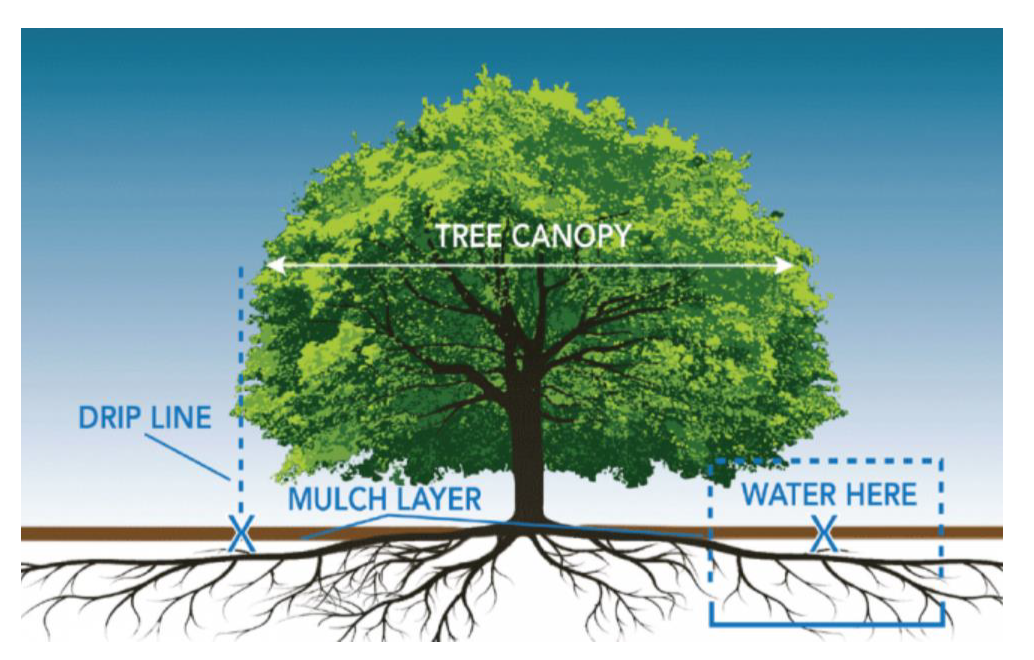- a broken/hanging branch
- a branch that is hanging lower than six feet off the ground that is over the sidewalk, street or driveway
- a dead branch that is OVER 2” in diameter a branch that is causing a site obstruction or is blocking a street sign
Tree Disease Resources
The treatment method used for a particular insect or disease problem depends on the species involved, the extent of the problem, and a variety of other factors specific to the situation and local regulations. The City of Naperville only treats for Emerald Ash Borer. If you suspect your tree is suffering from one of the below diseases, the City recommends consulting a Certified Arborist if you have questions about the nature of the problem or the proper treatment method to use.
Below is a list of resources from The Morton Arboretum about tree diseases that are common to the Naperville-area.
Additional Resources
There are several local organizations that provide resources and services related to tree health. A list of more resources for tree-related questions is available below.
- The Morton Arboretum: The Plant Clinic
- The Morton Arboretum: Tree Care Quick Facts
- Chicago Region Trees Initiative: Resources
Tree Watering
Applying the proper amount of water is important to your tree’s health. Under-watering can cause a decline in the growth and health of trees and shrubs, while over-watering can cause spaces normally occupied by oxygen to become filled with water; which could result in root suffocation and root rot. Either situation can result in tree decline and tree death.
Helpful Tips
Water once every 7 to 10 days, depending on rainfall. A weekly watering is more beneficial than frequent light or daily watering. It is better to water in the early morning or late afternoon when the evaporation rate is at its lowest point.
Check soil moisture. Dig a small hole and feel soil to determine if it is wet, moist, or dry at the root level. Otherwise, use a tensiometer to determine water tension. The majority of a large tree’s roots are in the upper 12 to 18 inches of soil.
Give an inch. Most trees require 1 inch of water per week during the growing season (in absence of rainfall). To illustrate what one inch of water looks like, consider the root system of a large tree. A large tree root system can spread out to a 30’ x 30’ area. To provide 1 inch of water to this 30’ x 30’ area, 560 gallons of water or over ten 55-gallon water barrels would be needed. This translates to a garden hose flowing at full capacity for nearly one hour to deliver 1 inch of water. A garden hose connected to a water sprinkler reduces the water flow and requires more time to deliver 1 inch of water. To gauge your sprinkler’s flow rate, place a collection cup on top of the ground under the watering stream.
Position water flow. Oscillating sprinklers work well if placed on the ground next to the trunk with watering stream directed out towards the dripline. The water stream should NOT spray the tree bark. Water is primarily absorbed by the root system, so avoid sprinkling the leaves/needles to avoid creating fungus diseases. Soaker hoses use less water than sprinklers, however, soaker hoses must be moved frequently for good coverage.
Preserve soil moisture. Adding a 2-4” deep organic mulch layer to the soil surface will reduce evaporation from the soil and eliminate competition for water and nutrients from turf and other competing plants. Keep the mulch off the trunks of the trees. Mulch like a donut, not like a volcano.
Dry Spells and Heat Stress
Water deficit - The combination of sparse rainfall and high heat temperatures lead to a dangerous water deficit for trees. Shallow and thin root systems found in urban trees are vulnerable to drying out (especially for trees in poor condition).
Leaf drop and leaf scorch - Some trees respond to heat stress by dropping some leaves, thereby limiting the loss of water through their leaves. Other trees develop leaf scorch (brown, dry leaf edges) when they cannot keep up with the water demand caused by hot weather.
Prioritize watering needs - Trees can be permanently damaged and may not recover, so watering ‘at risk’ trees is most important. Vulnerable trees may include:
- Recently transplanted or young trees
- Damaged trees, such as those with damaged root systems
- Susceptible tree species, such as Ash
- Sensitive tree species, such as Sugar and Norway Maple
- Floodplain tree species, such as Oak, River Birch, and Red Maple
- Confined trees, including those with confined roots in planters or parking islands
- Trees grown outside their normal geographical range
- Any favored tree

(Tree watering tips and image courtesy of BARTLETT TREE EXPERTS, Bolingbrook IL.)
Protect Your New Tree During the 2024 Cicada Emergence
This year, the Chicago region will see a remarkable natural phenomenon that only occurs once in 17 years: an emergence of periodical cicadas. During this time, any tree you plant this spring will be vulnerable to cicada damage. To avoid damage, the Morton Arboretum suggests wrapping the new tree in netting. For more information, visit the Morton Arboretum's 2024 Cicada Emergence information page.
Don't Forget - JULIE Before You Dig
Always call JULIE 48 hours before you dig. You can make a request 24 hours a day, 7 days a week. Call 811 or (800) 892-0123 or submit a request online.
Related Links
- Parkway Planting Guidelines
- Parkway Tree Planting Permit Application
- New Construction Ordinance Planting Permit
- Landscaping and Clearance Requirements
- Submit a Parkway Tree Service Request
- Tree Disease Resources